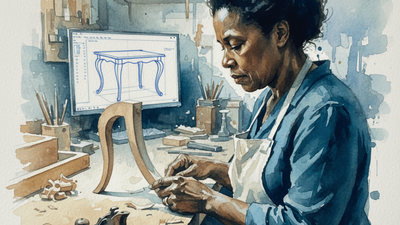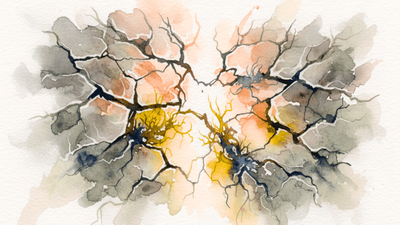AI Transformation Demands Leadership Transformation

Record investment levels show that business leaders grasp AI's potential. Yet only 1% of organisations report capturing significant value from AI at scale, according to research from the London School of Economics. The failure isn't only technological. The human factor is still a critical influence, specifically, leadership failing to evolve.
Executives are demanding that their organisations change faster, act smarter, and become more adaptive, while leading in the same ways they always have. They expect middle managers to master AI tools and agility, yet stay insulated from the same disruption themselves. This results in stalled transformations, cynical teams, and a widening gap between AI ambition and real impact.
AI transformation cannot be led by leaders who remain unchanged themselves.
The Vanishing Middle: A Mirror for Leadership
If leadership continues to lag, the impact on well-crafted careers can be immense. We see that across industries, where middle management is disappearing. As AI automates coordination, dashboards, and reporting, the layers built for control are thinning. According to research from India Today, "Roles that were primarily administrative are being cut because they no longer add value."
The managers who remain are of a different calibre: tech-literate, operationally savvy, and deeply human. They use AI to handle the routine so they can focus on judgment, empathy, and culture. As the research notes, "Those who have adapted over the last two years are thriving. Those who haven't been at risk of being left behind."
Executives face the same reckoning. The forces reshaping middle management are moving upward. The question is not whether AI will redefine executive work, but whether leaders will redefine themselves first.
What Leadership Transformation Really Requires
Harvard Business Review research by Herminia Ibarra and Michael G. Jacobides shows that failed AI programmes share a common flaw: leaders cling to old roles. They deploy new technologies without reimagining how decisions, power, and collaboration should work. As the research emphasizes, "The failure to capture value from new technologies is rarely about the technology. Instead, it's typically about failing to align your technology to your value proposition, and missing the opportunity to leverage technology to change the organisation."
To lead effectively in the AI era, executives may need to evolve how they show up, not by adding more tools, but by expanding their range. Three shifts, in particular, are proving powerful.
First, look outward. The leaders who stay relevant are those who cross boundaries, borrowing ideas from other industries and inviting new perspectives into their strategy conversations. When Satya Nadella brought founders of small acquired startups into Microsoft’s senior offsites, he signalled that learning from the edges was as valuable as expertise from the core.
Second, design for simplicity. Leaders like SAP’s CFO Dominik Asam show how AI transformation succeeds when executives actively strip out unnecessary complexity. By automating routine finance work, he freed teams to focus on creative, high-value decisions, a compelling demonstration that structure redesign, not tool adoption, unlocks real productivity gains.
And third, lead through coaching, not inspection. Jean-Philippe Courtois at Microsoft replaced a compliance-driven culture with one grounded in trust and guidance, enabling teams to experiment and grow faster. Across industries, organisations that cultivate this coaching mindset find that it amplifies both capability and morale.
These shifts require more than skill acquisition. They show how structure and behaviour must evolve together.
The Courage to Redesign Your Own Role
Understanding this is easy; living it isn't. Transformation demands dismantling the very systems that once rewarded you—flattening hierarchies, distributing authority, and modelling vulnerability in cultures built on control.
The executive who thrives in the AI era will look nothing like the one who succeeded before it. Power, priorities, and even measures of success are changing. The courage required isn't the courage to bet on technology; it's the courage to become obsolete in your current form so you can lead in a new one.
Middle management offers a preview. The India Today research shows that "The next-generation manager will be both a technologist and a mentor—fluent in data, adaptive to AI, and emotionally intelligent." Executives will need the same synthesis—fluency in AI-enabled work, clarity on outcomes, and deep human skill in leading through uncertainty.
Why Executive Mastery Matters
AI transformation is, at its core, a leadership transformation. Executives are called on to adapt their own capabilities while performing, learn while leading, and redesign while delivering. This is where coaching for Executive Mastery becomes mission-critical.
Are you willing to be transformed by the transformation you're leading?
If yes, here are three commitments to guide your thinking:
- Acknowledge that what made you successful may now hold your organisation back. The practices that served you in the pre-AI era may be barriers in the AI era.
- Recognise that leadership evolution and organisational design are inseparable. You cannot develop new leadership capabilities in structures designed to prevent them. Both must transform together.
- Invest in the frameworks and coaching that make both possible, whether it’s coaching for yourself or your team, or a more in-depth look into how to enhance your organisation’s AI-readiness for the opportunities ahead.
The leaders who make these commitments won't just survive the AI era, they'll define it.
- Schedule a Partnership Alignment Call to discover more about Executive Mastery
- Download the FORS Executive Briefing
- Learn more about our approach to organisational transformation
Subscribe to the FORS Report
Be the first to know - subscribe today





Member discussion